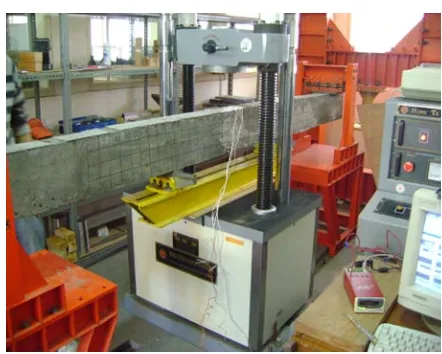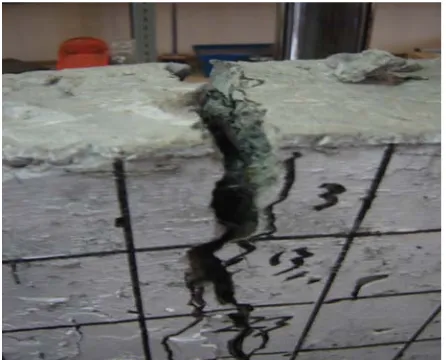Susilorini – The Performance Of Slim Concrete Beam Using Nylon Mesh Confinement INTRODUCTION
Confinement has become significant way to improve ductility of concrete structure member which is very important in concrete earthquake resitant design. When a requirement of ductile-resistant concrete structure member is provided by beam concrete, then its performance should be supported by strength effort in reducing the hazard of earthquake, in example, by introducing the nylon mesh confinement. For slim beam, which has slenderness ratio of and more than 5, it is important to determine how the beam behave during the loading history.
Park and Paulay (1975) explain that the me-chanism of confining effect is not so simple. When compressive stress achieved in lower value, transversal reinforcement is stressed, but it is lightly, then the reinforcement will not
affect the concrete area. If only ultimate stress achieved, the transversal strain of concrete is increase, and crack propagation will be generated. Because of the phenomenon, concrete is expanding and then will compress
the transversal reinforcement. In case
compresive area confined, then the ductility of beam will be improved.
Concrete beam should be designed in ductile way to assure its earthquake resistance. When slim beams applied to the structure, its failure mechanism will become very important consideration. According to Nawy (1996), slim beams are categorized by slenderness of ratio of shear span, a, and effective depth, d, of beam. Slim beams have slenderness of more than 5, while moderate slim beams have slenderness of 2.5-5, and deep beams have slenderness of less than 1. Generally, the performance of slim beams are subjected to
THE PERFORMANCE OF SLIM CONCRETE BEAM USING NYLON MESH CONFINEMENT
Rr. M.I. Retno Susilorini1) 1)
e-mail:
Department of Civil Engineering, Faculty of Engineering, Faculty of Engineering Soegijapranata Catholic University, Semarang
ABSTRACT
Confinement has become significant way to improve ductility of concrete structure member which is very important in concrete earthquake resitant design. When a requirement of ductile-resistant concrete structure member is provided by beam concrete, then its performance should be supported by strength effort in reducing the hazard of earthquake, in example, by introducing the nylon mesh confinement. For slim beams, it is important to determine how the beam behave during the loading history. This research investigates the performance of slim beam using nylon mesh confinement. The research is conducted experimentally by some specimens of slim beams which are unconfined and confined by nylon mesh. All specimens have: f’c design = 40 MPa, b = 10 cm, d = 20 cm, a = 100 cm, L = 300 cm, and slenderness ratio 5. The confinement made of nylon mesh with mesh spacing of 5 cm. Nylon mesh consists of nylon fibers with diameter of 1.1 mm which are assembled to be mesh. The specimens are tested by third point flexural beam test by compute-rized UTM and data logger of strain gauges.The research meets conclusions: (1) The confined slim beams perform higher maximum load with same displacement of 70 mm; (2) The confined slim beams perform ductile behaviour with strain-hardening character in ultimate stage while the unconfined beam does not; (3) The curvature of ductility ratio and curvature of slim beams of confined slim beams are about the same; (4) The unconfined slim beam shows less cracks compared to confined one while it achieves lower ultimate load and perform lower value of curvature of beam; (5) The confined slim beams perform higher ductility compared to unconfined beam; and (6) The nylon mesh significantly improve the ductility of slim beam and perform good performance of earthquake resistant concrete structure member.
shear, but this paper want to discuss its flexural performance as well while nylon mesh confinement applied.
Some previous researches emphazise the advantage of confinement to improve beam ductility such as Wu and Sun (2005) use thin CFRC (continuous fiber reinforced cement) and CFRC (continuous fiber reinforced polymer) sheets for structural retrofit as external wrap to achieve maximum load; Rafeeqi, Lodi, and Wadalawala (2005) upgrade and strengthen beams with ferrocement strips and wraps with one or two layers of wire mesh; Delalibera and Giongos (2008) apply additional transversal reinforcement of stirrups in compression area. Nylon mesh confinement has been applied in concrete beams by Setyanegara and Sagitha (2008), Lelono and Widi (2009), Susilorini, et. al. (2009), Susilorini (2009a-d). Those researches have shown significant ductility improvement of beam. It can be understood because nylon fiber that is applied into cementitious matrix has advantages such as great value of tension strength and elongation also unique characteristic of ‘yield point elongation’ (Susilorini, 2007; 2008; 2009e,f).
Analitically, two parameters (Park and Paulay, 1975) discussed in this paper can be explained by equations (1)-(3) as follow.
The rotation of beam can be expressed by
x material’s modulus of elasticity, I = beam’s moment of inertia computed about the neutral axis.
The curvature of ductility is
EI
It is important to learn behaviour of confined slim beams, hence, this research investigates the performance of slim beam using nylon mesh confinement.
METHODS
This research is conducted experimentally by some specimens of slim beams which are
unconfined and confined by nylon mesh. All specimens have: f’c design = 40 MPa, b
(width) = 10 cm, d (depth) = 20 cm, a (shear span) = 100 cm, L (span) = 300 cm. The specimens consists of one unconfined slim beam and 3 confined slim beams with slenderness ratio (a/d) of 5. The confinement made of nylon mesh with mesh spacing of 5 cm. Nylon mesh consists of nylon fibers with diameter of 1.1 mm which are assembled to be mesh which covers the steel bar (Figure 1). The specimens are tested by third point flexural beam test by computerized UTM and data log-ger of strain gauges (Figure 2).
Figure 1. Nylon mesh with mesh spacing of 5 cm which cover the steel bar (Susilorini, 2009b)
Figure 2. Experimental set-up with computerized UTM and data logger of strain gauges (Susilorini, 2009b)
RESULTS AND DISCUSSION
Susilorini – The Performance Of Slim Concrete Beam Using Nylon Mesh Confinement mm (Figure 3). The load-displacement curve
described by Figure 3 also shows that the confined slim beams perform ductile behaviour with strain-hardening character in ultimate stage while the unconfined beam does not.
Figure 3. Load-displacement relation of beam speci-mens (Modified from Susilorini, 2009)
Figure 4. Curvature of beam specimens at ultimate load (Modified from Susilorini, 2009)
However, as explained by Table 1, the curvature of ductility ratio of confined slim beams are about the same, it ranged about 1.16-1.29 while for the unconfined one is 1.2. The curvature of slim beams are also about the same, 0.00000080-0.00000096. It is clear that the most important performance distinctions between the unconfined and confined slim beams are higher ultimitate load of the confined slim beams and strain-hardening
character in ultimate stage of load-displacement curve of confined slim beams.
Table 1. The value of curvature of beam specimens at ultimate load
NO SPECIMEN CODE
CURVATURE DUCTILITY
RATIO
CURVATURE OF BEAM
ROTA TION (rad)
µφ Κ θ
1 BL-0-C-A-03 1.200 0.0000008091 0.105
2 BL-JN-I-B-01 1.157 0.0000009675 0.107
3 BL-JN-I-B-02 1.292 0.0000008765 0.109
4 BL-JN-I-B-03 1.293 0.0000009068 0.099
Failure mechanism of slim beams can be observed by crack pattern of slim beams at ultimate stage of displacement of 70 mm (Figure 7). The unconfined slim beam shows less cracks compared to confined one while it achieves lower ultimate load and perform lower value of curvature of beam (Figure 5, 7, and Table 1).
Figure 5. Curvature of beam specimens during loading history (Susilorini, 2009b)
Figure 6. Crack at middle span of beam specimens at ultimate stage (Susilorini, 2009b)
(a)
(b)
(c)
(d)
Figure 7.
Crack patern of beam specimens at ulti-mate load (Susilorini, 2009b)(a) BL-0-C-A-03 (b) BL-JN-I-B-01 (c) BL-JN-I-B-02 (d) BL-JN-I-B-03
CONCLUSIONS
This paper meet conclusions:
1. The confined slim beams perform higher maximum load with same displacement of 70 mm
2. The confined slim beams perform ductile behaviour with strain-hardening character in ultimate stage while the unconfined beam does not.
3. The curvature of ductility ratio and curvature of slim beams of confined slim beams are about the same
4. The unconfined slim beam shows less cracks compared to confined one while it achieves lower ultimate load and perform lower value of curvature of beam
5. The confined slim beams perform higher ductility compared to unconfined beam 6. The nylon mesh significantly improve the
ductility of slim beam and perform good performance of earthquake resistant concrete structure member
ACKNOWLEDGEMENT
This research was carried out with the finan-cial support of Competence Grant (Hibah Kompetensi) 2009 of author that is funded by Directorate of Research and Service to Society (Direktorat Penelitian dan Pengabdian kepada Masyarakat, DP2M), Directorat of Higher Learning (Direktorat Pendidikan Tinggi), Indonesia.
REFERENCES
Delalibera, RG., dan Giongo, JS. (2008). “Theoritical and Numerical Analysis of Reinforced Concrete Beams with Confinement Reinforcement”, IBRACON Structures and Materials Journal, Vol. 1(1): 17-30.
Hibbeler, R.C. (1997). Mechanics of Materials, International Ed, Third Ed., Prentice Hall, Inc. New York.
Lelono, Andri, dan Widi, Ida Bagus. (2009). “Kinerja Kuat Lentur pada Balok Beton dengan Pengekangan Jaring-jaring Nylon dan Expanded Metal”. Undergraduate Thesis. Department of Civil Engineering, Unika Soegijapranata, Semarang.
Merdana, I Nyoman. (2004). “Perilaku Hubungan Beban-Displasemen Pada Balok Beton Mutu Tinggi Dengan Kelangsingan Sedang.” Jurnal Teknologi, Vol.28(6): 63-71.
Susilorini – The Performance Of Slim Concrete Beam Using Nylon Mesh Confinement Park, R., and Paulay, T. (1974). Reinforced
Concrete Structure, John Wiley & Sons Inc., New York.
Rafeeqi, SFA., Lodi, SH., and Wadalawala. (2005). “Behaviour of Reinforced Concrete Beams Strengthened in Shear.” Journal of
Ferrocement , International Ferrocement Information Center, Asian Institute of Technology, Vol. 35(1): 479-489.
Setyanegara, E. dan Sagitha, S Adhitya. (2008). “Kinerja Kuat Lentur pada Balok Beton dengan Pengekangan Jaring-Jaring Nylon”. Undergraduate Thesis. Department of Civil Engineering, Unika Soegijapranata, Semarang. Susilorini, Retno, M.I. (2007). “Model Masalah
Cabut-Serat Nylon 600 Tertanam dalam Matriks Sementitis yang Mengalami Fraktur”. Dissertation. Unika Parahyangan, Bandung. Susilorini, Retno, M.I. (2008). “Model Cabut-Serat
Nylon 600 Tertanam dalam Matriks Sementitis Berbasis Fraktur.” Semesta Teknika Journal, Universitas Muhammadiyah Yogyakarta, Vol. 11(1): 38-52.
Susilorini, Rr. M.I Retno. (2009a). ‘A Miracle’ of Nylon Mesh – Striving for ‘Green Concrete’ Performance, Unika Soegijapranata Publisher, Semarang.
Susilorini, Rr. M.I Retno. (2009b). “Pemanfaatan Material Lokal untuk Teknologi Beton Ramah Lingkungan yang Berkelanjutan.” Research Report. DP2M, Dikti. Indonesia.
Susilorini, Retno, M.I. Rr. (2009c). “‘Green’ Technol-ogy to Enhance the Ductility of Concrete Beam - The Advantage of Nylon Mesh Confinement.” Proceedings of Second Annual International Conference Green Technology and Engineer-ing, 15-17 April, 2009: 96-99, Universitas Mala-hayati, Lampung.
Susilorini, Retno, M.I. Rr. (2009d). “Failure Analysis of Nylon Mesh as Beam Confinement Based on Fracture Mechanics Approach.”, Proceedings of The 11th International Conference on QIR (Quality of Research), 2-5 Agt, 2009: B-P2-3;1-6, Faculty of Engineering, University of Indonesia.
Susilorini, Retno, Rr. M.I.(2009e). Pemodelan Cabut-Serat Berbasis Fraktur, Unika Soegijapranata Publisher, Semarang.
Susilorini, Retno, M.I. Rr. (2009f). “The Fractured-Based Modeling of Pull-Out Problem with Long Embedded Nylon 600.” Dinamika Teknik Sipil Journal, Universitas Muhammadyah Surakarta, Vol. 9(1): 134-140.


